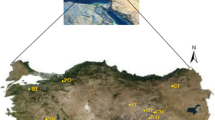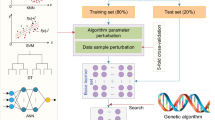Abstract
Uniaxial Compressive Strength (UCS) is considered as one of the most important parameters in designing rock structures. Determination of this parameter requires preparation of rock samples which is costly and time consuming. Moreover discrepancy of laboratory test results is often observed. To overcome the drawbacks of traditional method of UCS measurement, in this paper, predictive models based on neuro-genetic approach and multivariable regression analysis have been developed for predicting compressive strength of different type of rocks. Coefficient of determinatoin (R2) and the Mean Square Error (MSE) were calculated for comparison of the models’ efficiency. It was observed that accuracy of the neuro-genetic model is significantly better than regression model. For the neuro-genetic and regression models, R2 and MSE were equal to 95.89 % and 0.0045 and 77.4 % and 1.61, respectively. According to sensitivity analysis for neuro-genetic model, Schmidt rebound number is the most effective parameter in predicting UCS.





Similar content being viewed by others
References
Altindag R, Guney A (2005) Effect of the specimen size on the determination of consistent shore hardness values. Int J Rock Mech Min Sci 42:153–160
Alveraz Grima M, Babuska R (1999) Fuzzy model for the prediction of unconfined compressive strength of rock samples. Int J Rock Mech Min Sci 36:339–349
Atici U (2011) Prediction of the strength of mineral admixture concrete using multivariable regression analysis and an artificial neural network. Expert Sys Appl 38:9609–9618
Aydin A, Basu A (2005) The Schmidt hammer in rock material characterization. Eng Geol 81:1–14
Basu A, Kamran M (2010) Point load test on schistose rocks and its applicability in predicting uniaxial compressive strength. Int J Rock Mech Min Sci 47:823–828
Bell FG (1978) The physical and mechanical properties of the fell sandstones, Northumberland, England. Eng Geol 12:1–29
Bell FG (2005) Rock properties and their assessment. In: Selley RC, Cocks LRM, Plimer IR (eds) Encyclopedia of geology. Elsevier, Amsterdam, pp 566–580
Bieniawski ZT (1974) Estimating the strength of rock materials. J S Afr Inst Min Metall 74:312–320
Bieniawski ZT (1975) Point load test in geotechnical practice. Eng Geol 9(1):1–11
Bornholdt S, Graudenz D (1992) General asymmetric neural networks and structure design by genetic algorithms. Neural Netw 5:327–334
Broch E, Franklin JA (1972) Point-load strength test. Int J Rock Mech Min Sci 9(6):241–246
Cevik A, Sezer EA, Cabalar AF, Gokceoglu C (2011) Modeling of the uniaxial compressive strength of some clay-bearing rocks using neural network. Appl Soft Comput 11:2587–2594
Demirdag S, Tufekci K, Kayacan R, Yavuz H, Altindag R (2010) Dynamic mechanical behavior of some carbonate rocks. Int J Rock Mech Min Sci 47:307–312
Doberenier L, DeFreitas MH (1986) Geotechnical properties of weak sandstones. Geotechnique 36:79–94
Dube AK, Singh B (1972) Effect of humidity on tensile strength of sandstone. J Mines Met Fuels 20(1):8–10
Fener M, Kahraman S, Bilgil A, Gunaydin O (2005) A comparative evaluation of indirect methods to estimate the compressive strength of rocks. Rock Mech Rock Eng 38(4):329–343
Fogel DB, Fogel LJ, Porto VW (1990) Evolving neural networks. Biol Cybern 63:487–493
Garret JHJ (1994) Where and why artificial neural networks are applicable in civil engineering. J Comput Civil Eng 8(2):129–130
Goldberg DE (1989) Genetic Algorithms in Search. Addison-Wesley, Optimization and Machine learning
Hale PA, Shakoor A (2003) A laboratory investigation of the effects of cyclic heating and cooling, wetting and drying, and freezing and thawing on the compressive strength of selected sandstones. Environ Eng Geosci 9(2):117–130
Hansem J, Meservy R (1996) Learning experiments with genetic optimization of a generalized regression and neural network. Decis Support Syst 18:317–325
Haramy KY, DeMarco MJ (1985) Use of Schmidt hammer for rock and coal testing. In: 26th US Symposium on Rock Mechanics, 26–28 June, Rapid City Balkema, Rotterdam, pp 549–555
Holland J (1975) Adaptation in Natural and Artificial Systems. University of Michigan Press, Ann Arbor
Huang Y (1999) Application of artificial neural networks to predictions of aggregate quality parameters. Int J Rock Mech Min Sci 36:551–561
Huang Y, Wanstedt S (1998) The introduction of neural network system and its applications in rock engineering. Eng Geol 49:253–260
ISRM (1985) Suggested method for determining point-load strength. Int J Rock Mech Min Sci 22:53–60
Jennrich RI (1995) An introduction to computational statistics-regression analysis. Prentice-Hall, Englewood Cliffs, NJ
Kahraman S (2001) Evaluation of simple methods for assessing the uniaxial compressive strength of rock. Int J Rock Mech Min Sci 38:981–994
Kahraman S, Fener M, Gunaydin O (2002) Predicting the Schmidt hammer values of in situ intact rock from core samples values. Int J Rock Mech Min Sci 39(3):395–399
Katz O, Reches Z, Roegiers JC (2000) Evaluation of mechanical rock properties using a Schmidt Hammer. Int J Rock Mech Min Sci 37(4):723–728
Kayabali K, Selcuk L (2010) Nail penetration test for determining the uniaxial compressive strength of rock. Int J Rock Mech Min Sci 47:265–271
Kelessidis VC (2011) Rock drillability prediction from in situ determined unconfined compressive strength of rock. J S Afr Inst Min Metall 111:429–436
Khaksar A, Taylor PG, Fang Z, Kayes T, Salazar A, Rahman K (2009) Rock strength from core and logs: where we stand and ways to go. Paper SPE 121972, presented at the EUROPEC/EAGE Annual Conference and Exhibition, Amsterdam
Kim GH, Yoon JE, An SH, Cho HH, Kanga KI (2004) Neural network model incorporating a genetic algorithm in estimating construction costs. Build Environ 39:1333–1340
Lee S (2003) prediction of concrete strength using artificial neural networks. Eng Struct 25:849–857
Lin S, Punch W, Goodman ED (1995) A hybrid model utilizing genetic algorithms and hopfield neural networks for function optimization. Proceeding of the Sixth International Conference on Genetic Algorithms, Morgan Kaufmann, San Francisco
Mc Culloch WS, Pitts W (1988) A Logical Calculus of the Ideas Immanent in Nervous Activity. Bull Math Biophys 5:115–133
Meddah MS, Zitouni S, Belaabes S (2010) Effect of content and particle size distribution of coarse aggregation the compressive strength of concrete. Constr Build Mater 24:505–512
Moradian Z, Behnia M (2009) Predicting the uniaxial compressive strength and static Young’s modulus of intact sedimentary rocks using the ultrasonic test. Int J Geomech :14–19
Niculescu SP (2003) Artificial neural networks and genetic algorithms in QSAR. J Mol Struct 622:71–83
Nie X, Zhang Q (1994) Prediction of rock mechanical behavior by artificial neural network. A comparison with traditional method. IV CSMR, Integral Approach to Applied Rock Mechanics. Santiago
O’Rourke JE (1989) Rock index properties for geoengineering in underground development. Min Eng 106–110
Porto DR, Hurlimann M (2009) A comparison of different indirect techniques to evaluate volcanic intact rock strength. Rock Mech Rock Eng 42:931–938
Rigopoulos I, Tsikouras B, Pomonis P, Hatzipanagiotou K (2011) Microcracks in ultrabasic rocks under uniaxial compressive stress. Eng Geol 117:104–113
Russell AR, Wood DM (2009) Point load tests and strength measurements for brittle spheres. Int J Rock Mech Min Sci 46:272–280
Selver MA, Ardali E, Onal O, Akay O (2008) Predicting Uniaxial Compressive Strengths of Brecciated Rock Specimens using Neural Networks and Different Learning Models. IEEE. doi:10.1109/ISCIS.2008.4717937
Shalabi FI, Cording EJ, Al-Hattamleh OH (2007) Estimation of rock engineering properties using hardness tests. Eng Geol 90:138–147
Sharma PK, Singh TN (2008) A correlation between P-wave velocity, impact strength index, slake durability index and uniaxial compressive strength. Bull Eng Geol Environ 67:17–22
Sheorey PR, Barat D, Das MN, Mukherjee KP, Singh B (1984) Schmidt hammer rebound data for estimation of large scale in situ coal strength. Int J Rock Mech Min Sci Geomech Abstr 21:39–42
Singh RN, Hassani FP, Elkington PAS (1983) The application of strength and deformation index testing to the stability assessment of coal measures excavations. Proceedings of the 24th US Symposium on Rock Mech, Texas A&M University, AEG Balkema, Rotterdam, pp 599–609
Singh VK, Singh D, Singh TN (2001) Prediction of strength properties of some schistose rocks from petrographic properties using artificial neural networks. Int J Rock Mech Min Sci 38:269–284
Sivanandam SN, Deepa SN (2008) Introduction to Genetic Algorithms. Springer, Berlin, Heidelberg
Ulusay R, Tureli K, Ider MH (1994) Prediction of engineering properties of a selected litharenite sandstone from its petrographic characteristics using correlation and multivariate statistical techniques. Eng Geol 38(2):135–157
Ulusay R, Gokceoglu C, Sulukcu S (2001) Draft ISRM suggested method for determining block punch strength index (BPI). Int J Rock Mech Min Sci 38:1113–1119
Vasconcelos G, Lourenco PB, Alves CSA, Pamplona J (2007) Prediction of the mechanical properties of granites by ultrasonic pulse velocity and Schmidt hammer hardness. Proceedings, 10th North American Masonry Conference, pp 981–991
Vasconcelos G, Lourenco PB, Alves CSA, Pamplona J (2008) Ultrasonic evaluation of the physical and mechanical properties of granites. Ultrasonic’s 48:453–466
Vishnu CS, Mamtani MA, Basu A (2010) AMS, ultrasonic P-wave velocity and rock strength analysis in quartzites devoid of mesoscopic foliations—implications for rock mechanics studies. Tectonophysics 494:191–200
Yasar E, Erdogan Y (2004) Estimation of rock physicomechanical properties using hardness methods. Eng Geol 71:281–288
Yilmaz I (2009) A new testing method for indirect determination of the unconfined compressive strength of rocks. Int J Rock Mech Min Sci 46:1349–1357
Zhang Q, Zhu H, Zhang L, Ding X (2011) Study of scale effect on intact rock strength using particle flow modeling. Int J Rock Mech Min Sci 48:1320–1328
Author information
Authors and Affiliations
Corresponding author
Rights and permissions
About this article
Cite this article
Monjezi, M., Amini Khoshalan, H. & Razifard, M. A Neuro-Genetic Network for Predicting Uniaxial Compressive Strength of Rocks. Geotech Geol Eng 30, 1053–1062 (2012). https://doi.org/10.1007/s10706-012-9510-9
Received:
Accepted:
Published:
Issue Date:
DOI: https://doi.org/10.1007/s10706-012-9510-9




